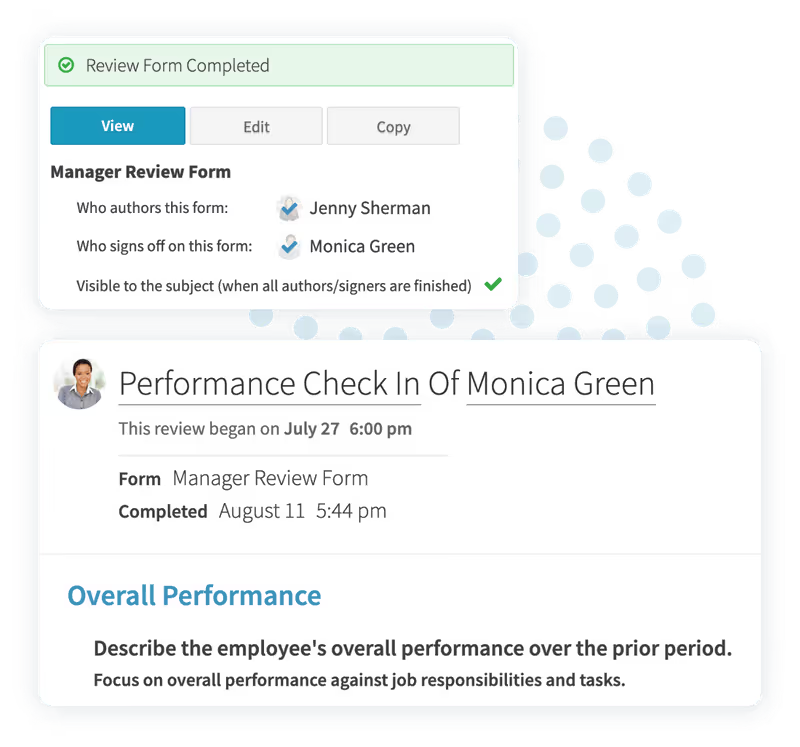Performance Check-ins vs Performance Reviews
If you’re heard the word “performance check-ins” talked about in performance management circles, you’ve likely had one of two reactions: what’s the big deal? It’s just another method of performance reviews, right?
Or, maybe, the Adobe innovation piqued your interest and you’re wondering whether to ditch your annual performance reviews like other companies have. Whatever you do, don’t allow the semi-sensationalized nature of employee check-ins to influence your perception of them. You may find that they’re not such a dramatic innovation after all--maybe they’re simply another method of measuring employee performance.
This article will help to better define the buzzword that is “check-ins” and maybe help you to analyze whether they are right--or wrong--for your employee performance conversations.
Performance check-ins are similar to performance reviews
In many ways, employee check-ins are not so different from traditional performance reviews. The main priority in both remains the same--to conduct effective one-on-one meetings with employees to discuss progress, goals, and share feedback.
The most significant difference is the frequency in which the meetings occur. The idea behind check-ins is to foster a more informal, ongoing dialogue between employees and their managers.
Some companies schedule mandated check-ins every month, while others schedule them as needed, or after completing major projects. Regardless of their specific schedule, the main purpose is to keep the lines of communication between employees and managers open so as to engage and manage employee performance more readily.

Adobe introduced the concept of employee check-ins in 2012 as a means of doing away with traditional performance reviews. As Adobe realized, and as many other companies have discovered, the annual performance review format tends to get bogged down by paperwork, bureaucracy, and unnecessary complexity. It can also lead to employees feeling limited by ranking and undervalued for performance.
While check-ins can be held with a more casual approach, it’s important that managers are still able to keep a loose structure intact in order to make the most of employee conversations. In an online setup, make you that you follow proper virtual meeting etiquette to keep things respectful and professional. Employees should walk away from each check-in feeling inspired and driven to action, having established clear goals and discussed pointed areas of development.
Check-ins were brought into play as a means of catalyzing change in the standard performance review format, and to help employees feel more engaged and empowered.
How check-ins differ from performance reviews
The purpose of check-ins is to ensure that employees are given the opportunity to understand their expectations, share feedback, and discuss the development that is needed to enhance their performance.
Much of the appeal for companies that have switched to check-ins is the informal nature of them. Instead of being scripted, check-ins can remain relatively casual for both employees and management. The idea is that more frequent, less formal communication will allow employees and managers to work better together in accomplishing goals, sharing feedback, and developing skills.
While check-ins can be held with a more casual approach, it’s important that managers are still able to keep a loose structure intact in order to make the most of employee conversations. Employees should walk away from each check-in feeling inspired and driven to action, having established clear goals and discussed pointed areas of development.
The benefit of holding more frequent check-ins is that managers have a better idea of what an employee is working on in that moment. Instead of providing vague references to the employee’s overall performance from an extended length of time, managers can point to specific projects, goals, or coaching points to hone in on during each meeting.
It’s also important to note that feedback shouldn’t be restricted to just check-ins or formal reviews--feedback should be given throughout the year, so that these discussions can focus on goal-setting under the assumption that the employee already has ideas of ways to improve.
Beware of micromanagement
To the manager, more frequent, informal check-ins can certainly seem like a solution to the problems presented by annual or traditional performance reviews. But check-ins aren’t without their pitfalls.
In the case of traditional performance reviews, employees often reported feeling left in the dark regarding their performance rating until the annual or quarterly meeting, which would often leave them even more confused and unmotivated. Holding less frequent reviews runs the risk of employees losing vision of their goals, and then being overwhelmed with feedback to the point that they walk away discouraged and criticized.
However, the opposite can become true of check-ins--instead of being left in the dark, check-ins create many opportunities for an employee to feel micromanaged. A Harvard Business Review article distinguishes the importance of “checking in” with an employee rather than “checking up” on them--in other words, establishing clear, meaningful goals while also giving them the autonomy to meet those goals.
If you’re considering check-ins
We’ve said it before, and we’ll say it again: Doing what’s right for your organization and your employees is key.
It’s not a bad thing to hold less frequent check-ins, especially if you believe in the success and capability of your employees. In many organizations, typically ones that are smaller, managers have found that checking in with employees is less needed when they are able to give employees clear strategic goals. This develops a sense of ownership in the work, and in turn, creates a nearly autonomous workforce that fosters healthy collaboration in management and employees.
In larger companies, however, frequent check-ins play a valuable role in making an employee feel heard, seen, and set up for success in achieving company goals. The increased communication fosters employee engagement, and, in the long run, can help your organization retain employees. Employee check-ins can also be used as a valuable way to measure a new hire’s experience.
Most importantly, managers should seek to establish a regular cadence of check-ins or performance reviews (no matter how frequent) that fits the needs of their organizational needs.


.jpg)

